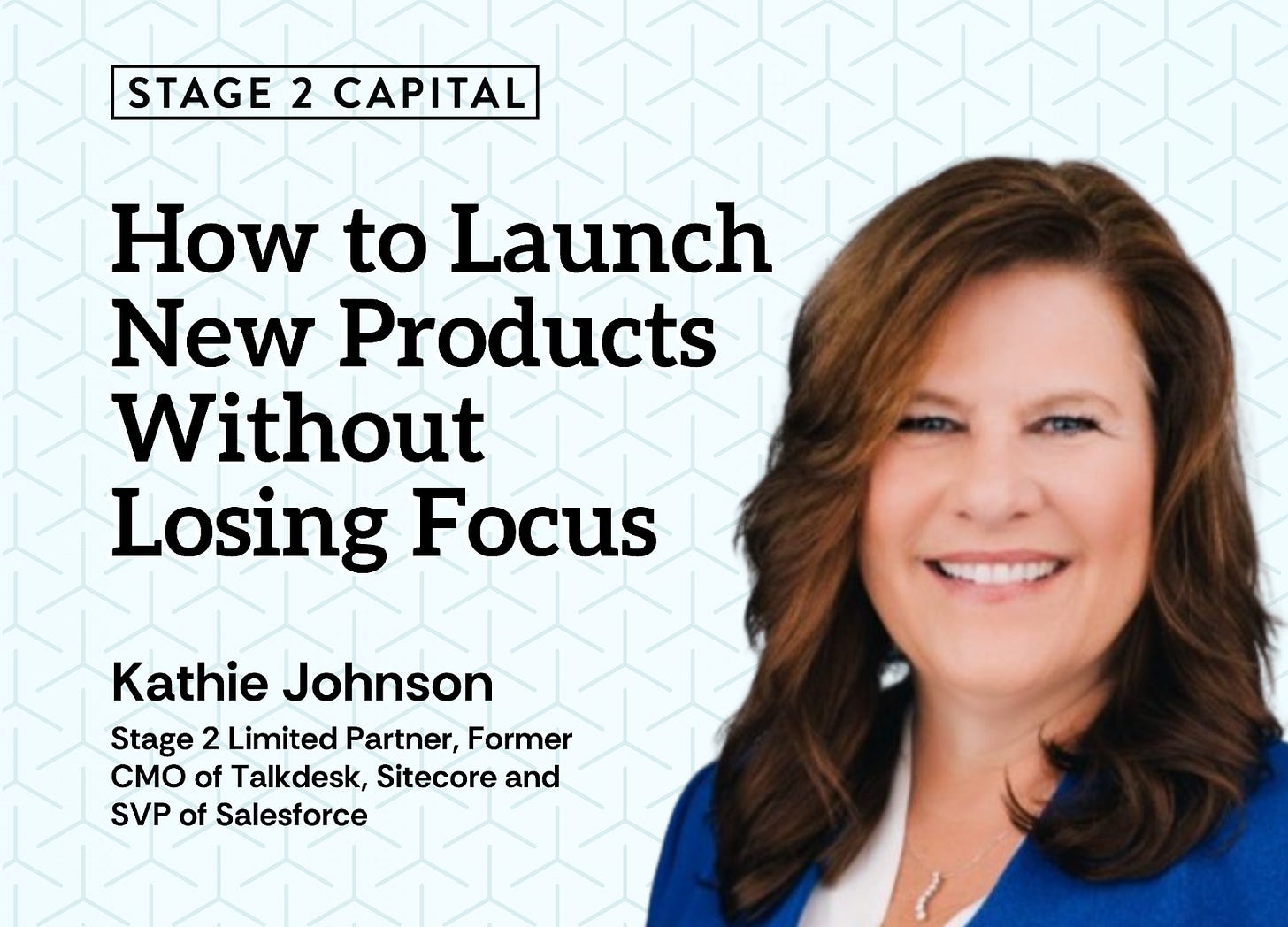How to Launch New Products Without Losing Focus
A guide to introducing a new product line without distracting your GTM team
DEAR STAGE 2: We’re getting ready to launch a new product line, but I’m worried about splitting focus for our GTM team. How do other companies manage this transition without derailing momentum? ~SPLITTING FOCUS
DEAR SPLITTING FOCUS: Launching something new is exciting, but your concerns around juggling priorities and fear of overextending your team are real.
I sat down with Kathie Johnson, Stage 2 LP, and former CMO of Talkdesk, Sitecore and SVP of Salesforce (just to name a few) to unpack how experienced go-to-market leaders manage this kind of shift without throwing their teams off balance.
Read on for her advice:
Start by Asking the Right Strategic Questions
Before you even think about putting a sales deck together, pause and evaluate:
Does this change your ideal customer profile?
Are you targeting a new vertical or segment?
Will the personas you’re engaging be different?
Is this an expansion motion or a completely new land?
If the answers point to a similar ICP, similar use case, and a path to expand existing customers, this launch shouldn’t derail your team. But if it’s a departure from your current focus, it’s important to treat it like a new motion.
Key Takeaway #1: Budget for the Distraction
Any and all new product launches will take time and attention. Kathie recommends setting aside a dedicated slice of your marketing resources, both budget and time, for testing.
“Ten percent of my marketing budget is always reserved for experimentation. That’s the pool I draw from when we want to go after something new.”
The percent may vary depending on your circumstances and the level of priority of this new launch, but the idea holds - that X% is your sandbox. Use it to:
Pressure test messaging and positioning
Validate ICP and segmentation
Build out early enablement and value props
Let marketing take the lead on planning the launch. Put them in the leadership seat and build the launch team for feedback around them…
Key Takeaway #2: Create a “Tiger Team”
You can’t ask everyone to focus on everything. Instead, build a cross-functional squad or “tiger team” representing sales, marketing, and product. You want input from all teams who will be impacted, but the goal is to pick a few people to represent the broader team to limit the distraction.
Give this team:
A clear charter (what you’re trying to validate)
A time constraint (4–6 weeks is a good start)
Specific deliverables (e.g., messaging doc, pitch deck, beta outreach)
When expectations are clear, team members can better manage new initiatives alongside their core responsibilities without feeling overwhelmed.
Key Takeaway #3: Bring Sales In After You’re Ready
Resist the urge to “future sell.” Sales teams are quota-driven and short-term focused by design. Bringing them in too early can hurt morale or distract from pipeline initiatives that’s already working.Instead:
Loop in sales leadership early so they can give feedback, are aligned with the plan and ready to support the launch when the time comes
Hold off on enablement until you’ve locked ICP, messaging, and use cases. Bring a fully baked GTM strategy to the launch.
Revisit comp and quotas if this product is going to be part of the sales team number make sure the incentives are aligned to the company goals.
“People do what they’re measured on,” says Kathie. “If you want this to be real, make sure you’re aligning incentives accordingly.”
Key Takeaway #4: Build Credibility Through Your Customers
If you’re expanding your product footprint with the same customers and buyers, start there. This is the fastest way to learn and build momentum.
Ask your Customer Advisory Board or a few key customers for input and fast feedback loops during development of both product and messaging.
Find a design partner and over-deliver to earn a case study or reference.
Launching into new personas or industries? Follow Kathie’s example from Salesforce:
“We didn’t just show up to industry events. We put our customers on stage. We brought in experts who were already respected in that field.”
If you’re not already known in the space, surround yourself with people who are. This might mean hiring advisors or partnering with influencers to build trust. Critically, you have to be creative about how to build credibility and get in front of the right audience.
Key Takeaway #5: Don’t Confuse a Feature with a Product
Kathie’s final warning: be crisp on product strategy. Is this a feature enhancement for your core product? Or is this really a new product that requires a different go-to-market motion?
“You need a clear product naming structure so your team and your customers don’t get confused. Not every roadmap item deserves a ‘launch.’”
If you can’t explain the difference to your sales team, your customers won’t get it either.
Launching a new product doesn’t have to be a distraction if you’re deliberate. Start with a small team, use your customer base to validate before you go wide and build the right assets to arm your sales team.
Until next week!



